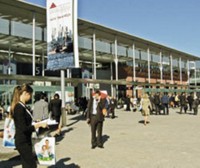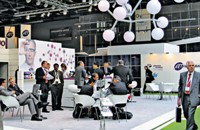Advertisement
Grab your lab coat. Let's get started
Welcome!
Welcome!
Create an account below to get 6 C&EN articles per month, receive newsletters and more - all free.
It seems this is your first time logging in online. Please enter the following information to continue.
As an ACS member you automatically get access to this site. All we need is few more details to create your reading experience.
Not you? Sign in with a different account.
Not you? Sign in with a different account.
ERROR 1
ERROR 1
ERROR 2
ERROR 2
ERROR 2
ERROR 2
ERROR 2
Password and Confirm password must match.
If you have an ACS member number, please enter it here so we can link this account to your membership. (optional)
ERROR 2
ACS values your privacy. By submitting your information, you are gaining access to C&EN and subscribing to our weekly newsletter. We use the information you provide to make your reading experience better, and we will never sell your data to third party members.
Business
New Bearings in Fine Chemicals
The pressures of a prolonged slump have diluted the Eurocentric nature of custom synthesis
by Rick Mullin
October 24, 2005
| A version of this story appeared in
Volume 83, Issue 43

The European custom fine chemicals manufacturers converging on Madrid for next week's CPhI pharmaceutical ingredients conference have spent the past five years rolling with the punches.
Competition from Asia, long threatened, is now a reality. The business has also shifted away from large pharmaceutical firms to emerging drug companies, biopharmaceutical firms, and virtual companies whose needs are different and whose prospects, generally, can only be called iffy. With that shift, the business has also tipped heavily toward the U.S., the center of the world's biopharma industry, where the weak dollar has increased pressure for players in Europe-the traditional home of pharma fine chemicals.
European companies hold somewhat divergent views on how well the sector has weathered the recent downturn and prepared itself for the future. The one common element to the European perspective is a commitment to the market and the perennial optimism about the year ahead.
Guy Villax, chief executive officer of Loures, Portugal-based Hovione, claims he saw the changes coming in the late 1990s and that Hovione welcomed some of them. They began with a migration of innovation in drug discovery and development. We saw that R&D and drug discovery was shifting away from large pharma to small pharma in 1998, Villax says. This, he said, played to the strength of Hovione, which that year also began work on a $19 million research and pilot-scale manufacturing center in East Windsor, N.J. The facility opened in 2003.
Villax contrasts his company's focus on process development and service with that of other fine chemicals operations, especially those operated by diversified chemical companies that, he says, focused strictly on large-scale production of active pharmaceutical ingredients (APIs) for major drug companies. The latter approach made sense in the late 1990s when big pharma business was booming, he says.
Ten years ago, most early-stage drug development was done in-house by large pharma, Villax says. They farmed manufacturing out in late-stage Phase III clinical trials. It was a great business to be in because you had little risk. In most cases, he says, the client had developed the process, and the contractor only had to run it. That wonderful, low-risk business is gone, Villax says. Now, you have to start at early phase; you have to do a lot of process development. You have to put up with a high percentage of failures. It's much tougher.
Villax says Hovione has worked on reducing operating costs to offset Asian competition. We ask process engineers to perform miracles, he says, and they usually do. Hovione has pushed to increase plant efficiency and produce steadier yields with shorter cycle times.
Degussa, one of the diversified European chemical companies that made high-priced acquisitions in custom manufacturing around 2000, has also been concentrating on developing niche technology, expanding small-scale services for emerging pharma and biopharma, and cost cutting. In addition, the company is considering investment options in China, says Rudolf Hanko, vice president of Degussa's exclusive synthesis business unit.
According to Hanko, the shift from large to small pharma is not as big a challenge to Degussa as the rise of India and China in fine chemicals. We have benefited from the shift to small pharma, he says. A substantial part of our business is with small pharma and virtual pharma, and it is a very profitable part of our business. Increased Asian competition, on the other hand, is one of the pressures that led to the recent $1 billion impairment charge at Degussa (C&EN, Oct. 10, page 14).
The charge, largely a goodwill write-down, addresses a sharp drop in earnings prospects in pharmaceutical fine chemicals, according to Degussa. Much of the charge relates to the performance of parts of the business added in 2001 with the acquisition of Laporte for about $2 billion.
Patrik Wohlhauser, president of exclusive synthesis and catalysts, says the charge-similar to one that Degussa took in 2003-is actually good news. Now we can get rid of a certain financial burden, he says. We are measured against return on capital employed, and goodwill was an important portion. As far as 2005 is concerned, there is one important message-we will be above the previous year in terms of our results. The year is not as bad as the impairment makes it look.
Degussa's Project House program has led to niche technologies in heterogeneous catalysis and biocatalysis, Hanko says. And the firm recently launched an automated process development tool called Alfred-for Advanced-Level Fast Reaction Engineering Device-that simulates multiple chemical reactions in parallel. We can basically simulate reactorlike conditions at a very small scale, Hanko says. The system, currently in use at the company's Hanau-Wolfgang, Germany, facility, was developed in partnership with lab automation firm Accelab.
Avecia has significantly realigned its pharmaceutical chemical business over the past six years. In the late 1990s, like others, we were enjoying very fast growth, says David Killworth, senior vice president of Avecia Pharmaceuticals. We were wondering what to do to get the most out of that growing market. The company made several investments, including the acquisition of Ontario-based Torcan.
The company aligned its pharmaceutical and fine chemicals businesses into a group called Life Science Molecules, which originally included biologics and fine chemicals for industry, agriculture, and pharmaceuticals. Avecia looked to grow them all, especially pharma and bio, Killworth says.
Following the remarkable downturn in outsourcing beginning in 2002, Killworth says, the company has restructured. Avecia's private equity owners also began divesting businesses. Avecia has exited its large-scale fine chemicals operations in Grangemouth, Scotland, most recently selling agricultural chemicals and some industrial fine chemicals to KemFine (C&EN, Sept. 26, page 11).
Killworth says the process will eventually include the biotechnology and pharmaceutical chemical businesses. Pharmaceutical chemicals are focused primarily at its Huddersfield, England, site. It had become increasingly clear in fine chemicals that cost is a significant determinant, Killworth says, noting that the exit from Grangemouth contributed significantly to a 40% overall operational cost reduction.
Killworth points out that Torcan is an important part of Avecia's increased focus on early-stage API production, which he says is also a strength at Huddersfield. Many biotech companies come to us with small molecules, and Torcan has an API service that is a perfect fit for the business. The company has also invested in high-potency actives at a facility it continues to operate in Grangemouth.
European firms share a commitment to the market and a perennial optimism about the year ahead.
Avecia has worked to develop proprietary technology of interest to drug firms, Killworth says, such as its catalytic asymmetric transfer hydrogenation (CATHy) and cyanohydrin catalyst (CACHy) technologies.
Technology development and divestiture took a new twist last year with Avecia's spin-off of Reaxa, an encapsulated catalyst technology company formed in partnership with Cambridge University. Avecia holds a 25% stake in it. With Reaxa, we have come up with an innovative way to develop technology at a time when margins are under pressure, Killworth says. We've defrayed the risk by bringing in the private sector.
Siegfried, a Swiss company whose heritage is almost entirely in pharmaceutical chemicals, experienced a falloff in recent years, but Eva Mssl, vice president of exclusive synthesis, argues that it had less to do with shifts in the market than with one particular contract that came to an end. We saw it coming in advance and very quickly reacted with a cost-cutting and restructuring program, says Mssl.
The net result, she says, is a flatter organization, a greater concentration on process development, and a better balance between exclusive contracts and multiclient products. Custom work has dropped from about 80% to about 60% of the revenue for the firm's Siegfried Actives division, she says, bringing the balance closer to that of the early 1990s when most of the work was in multiclient products.
Mssl says the multiclient business was bolstered with the acquisition this year of Penick, a specialist in controlled-substance narcotics in Newark, N.J.
Cost cutting has included typical downsizing of staff through retirement and some layoffs, Mssl says. Siegfried has also moved to reduce costs by purchasing inexpensive intermediate materials from China, aided by a purchasing office that opened in Shanghai last year.
Nick Green, president of Rhodia Pharma Solutions, says that, while much of the fine chemicals opportunity now comes from emerging pharma and biotech, there is still life in the big pharma market. He says Rhodia has both covered.
Rhodia's 2000 acquisition of ChiRex for $545 million is a prominent case of a diversified European firm spending top dollar on a custom synthesis business during the outsourcing heyday. Green, however, points to ChiRex as an integral part of Rhodia's approach to the emerging pharma market.
Recent years have seen a downsizing at Rhodia as a whole, including a 25% staff reduction at the Pharma Solutions site in Dudley, England. Last year, the division established an operating base in Deepwater, N.J., on a site rented from DuPont.
Despite the retrenchment in recent years, Green sees a resurgence in big pharma outsourcing in the years ahead. What was predicted in 2000 is still valid, he says. I still see big pharma reviewing its own business model. I think we all know it is not an industry that moves particularly fast, but I still see outsourcing as a valid option for them and one that they will increasingly use.
With all the changes, most firms agree that the Eurocentricity of custom synthesis has been permanently diluted. While some executives see this as industry maturation, others, like Hovione's Villax, see missed opportunity. The past five years are when Europe should have done something to face the Asian threat, he says. But with the downturn in business, globalization, and political haggling over REACH, Europe's chemical testing initiative, we in Europe didn't do terribly well.





Join the conversation
Contact the reporter
Submit a Letter to the Editor for publication
Engage with us on Twitter